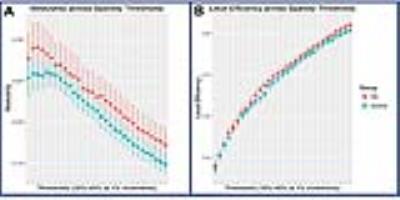2231
Graph-based network analysis of multi-echo resting-state fMRI data in people with high schizotypy1Institute of Psychiatry, Psychology & Neuroscience, King's College London, London, United Kingdom, 2Centre for Brain Health, University of British Columbia, BC, Canada
Synopsis
We applied graph theoretical network analysis on multi-echo resting-state fMRI data to examine whether healthy people with subclinical psychotic-like experiences (schizotypy) show abnormal functional brain topology compared to similar subjects without such experiences. While we did not observe significant between-group differences in any connectivity measure (Local and global efficiency, Modularity, and Small-worldness), within the schizotypy group we found that modularity and small-worldness were directly related to the severity of subclinical psychotic-like experiences. This demonstrates the feasibility of applying graph theory on multi-echo rs-fMRI in individuals with vulnerability for psychotic disorders and encourages the application of these methods in psychosis research.
Purpose
Recent studies using graph-based network analysis of resting-state functional magnetic resonance (rs-fMRI) data show abnormal functional network properties in schizophrenia1. Investigations of functional brain organization in high schizotypy, referring to healthy individuals presenting subclinical psychotic symptoms in the general population, may help elucidate etiological mechanisms of schizophrenia-spectrum disorders without confounds associated with antipsychotic medication or illness duration2. An important challenge in rs-fMRI research is distinguishing neuronally related signal fluctuations from nuisance signal fluctuations due to, e.g., subject motion, physiology, or hardware instability3. Our study used whole-brain multi-echo BOLD fMRI data, which improves the detection of BOLD-like components in rs-fMRI scans3, in order to examine functional network properties in people with high schizotypy, as well as their relationship with severity of symptoms and social functioning.Methods
A total of 42 healthy participants were enrolled in the study, according to their scores on the Unusual Experiences (UE) subscale of the Oxford and Liverpool Inventory of Feelings and Experiences (O-LIFE)4: 21 with high schizotypy (HS, O-LIFE UE > 7)) and 21 with low schizotypy (LS, O-LIFE UE < 2). Social functioning was measured with the Social Function Questionnaire (SFQ)5. Participants were matched on demographic variables. An 8-minute multi-echo rs-fMRI scan (TR=2500ms, TE’s=12, 28, 44, 60ms, spatial positions=32, time points=192, FOV=240×240, matrix=64x64, flip angle=80°, in-plane resolution=3x4mm2, slice thickness=3mm, slice gap=4 mm) and a magnetization-prepared rapid-acquisition gradient-echo (MPRAGE) T1 structural scan (TR=7312ms, TE=3016ms, inversion time=400ms, spatial positions=196, FOV=270×270 voxels, matrix=256x256, flip angle=11°, in-plane resolution=1x1.2mm2, slice thickness=1.2mm, slice gap=1.2mm) were acquired at 3T. Data were pre-processed using an optimal combination algorithm and Independent Components Analysis (ICA) for denoising6. Functional brain networks were constructed in GRETNA (https://www.nitrc.org/projects/gretna/), using a standard parcellation scheme to define 90 nodes in the graph. Graphs were binarized and sparsity-thresholded (range = 10-40%) before being compared to random graphs. Four global network properties were computed at a range of sparsity thresholds to index functional integration and segregation: Local efficiency (Eloc), Global efficiency (Eglob), Modularity, Small-worldness7. The groups (HS and LS) were compared using permutation tests in R (version 3.2.3, The R Foundation for Statistical Computing).Results
Both groups displayed similar Eglob, Eloc, modularity and small-worldness across the range of sparsity thresholds (p’s > .05, FDR-corrected, 10000 permutations). Figure 1 shows the values of modularity and local efficiency plotted by group to illustrate the effect of thresholding. Within the HS group, we found that modularity and small-worldnesss were positively associated with severity of psychotic-like experiences (r’s≧0.47, p’s<.05) (Figure 2). There was no association with local or global efficiency (r’s≦0.33, p’s>.05), and network properties were not related to social functioning (r’s≦0.37, p’s>.05).Discussion
This study found that global network properties are largely preserved in high schizotypy, contrary to a recent study using single-echo rs-fMRI in a similar population8. Nevertheless, we observed subtle changes in modularity and small-worldness associated with more severe schizotypal symptoms. In light of previous research showing functional dysconnectivity in schizophrenia1, our findings suggest that sizeable alterations in brain connectivity may appear later in the psychosis continuum, once psychotic features become exacerbated and the phenotype becomes clinically relevant.Conclusion
Our study demonstrates the feasibility of applying graph theory on multi-echo rs-fMRI in individuals with vulnerability for psychotic disorders. Future multi-echo rs-fMRI studies in other groups at higher risk of developing psychosis and with first-episode psychosis will inform how disruptions of brain connectivity relate to different vulnerability and disease states.Acknowledgements
This work was supported by a Brain & Behavior Research Foundation NARSAD Young Investigator Grant to G.M. (21200, Lieber Investigator). The authors wish to thank the National Institute for Health Research (NIHR) Biomedical Research Centre at South London and Maudsley NHS Foundation Trust and KCL for their on-going support of our neuroimaging research, and gratefully acknowledge the MRI radiographers for their expert assistance in this work, Meghan O’Sullivan for her help with subject recruitment and scanning, and our study participants.References
1. van den Heuvel MP, Fornito A. Brain networks in schizophrenia. Neuropsychology review. 2014;24(1):32-48.
2. Barrantes-Vidal N, Grant P, Kwapil TR. The role of schizotypy in the study of the etiology of schizophrenia spectrum disorders. Schizophrenia bulletin. 2015;41 Suppl 2:S408-416.
3. Kundu P, Inati SJ, Evans JW, Luh WM, Bandettini PA. Differentiating BOLD and non-BOLD signals in fMRI time series using multi-echo EPI. NeuroImage. 2012;60(3):1759-1770.
4. Mason O, Linney Y, Claridge G. Short scales for measuring schizotypy. Schizophrenia research. 2005;78(2-3):293-296.
5. Tyrer P, Nur U, Crawford M, et al. The Social Functioning Questionnaire: a rapid and robust measure of perceived functioning. The International journal of social psychiatry. 2005;51(3):265-275.
6. Kundu P, Benson BE, Baldwin KL, et al. Robust resting state fMRI processing for studies on typical brain development based on multi-echo EPI acquisition. Brain Imaging Behav. 2015;9(1):56-73.
7. Bullmore E, Sporns O. Complex brain networks: graph theoretical analysis of structural and functional systems. Nature reviews. Neuroscience. 2009;10(3):186-198.

